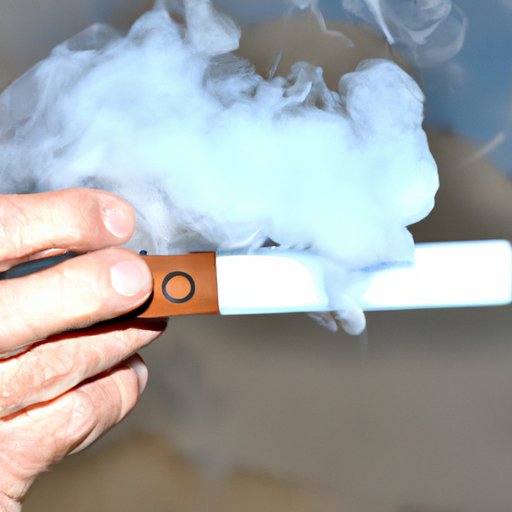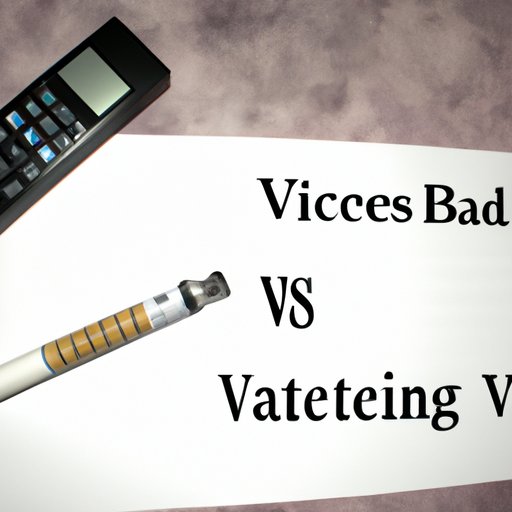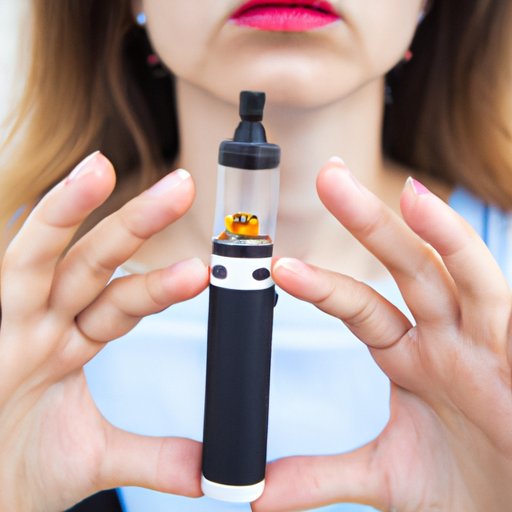Introduction
Smoking and vaping are two popular methods of consuming nicotine. To many, they may seem like similar activities, but it is important to consider the differences between them when determining which one is healthier. This article will explore the health risks associated with smoking and vaping, compare the safety of each method, investigate the impact of secondhand smoke and vapor, discuss the cost of smoking and vaping, and analyze the environmental impacts of both.

Comparing the Health Risks of Smoking and Vaping
The primary difference between smoking and vaping is the way in which the nicotine is delivered. When smoking, tobacco is burned and the resulting smoke contains thousands of chemicals, including nicotine. On the other hand, when vaping, a liquid containing nicotine is heated and the resulting vapor is inhaled. Because the vapor does not contain the same chemicals as smoke, some people believe that vaping is healthier than smoking.
To further understand the potential health risks of vaping compared to smoking, it is important to look at the available research. A 2017 study published in the journal Tobacco Control found that vaping is significantly less harmful than smoking. The study concluded that “switching completely from tobacco cigarettes to e-cigarettes confers substantial health benefits over continued smoking.” Similarly, a 2019 study published in the journal Annals of Internal Medicine found that adults who switched from smoking to vaping had “substantial short-term health benefits.”
Although there is evidence that vaping is less harmful than smoking, it is important to consider the potential long-term effects of vaping. Research on the long-term effects of vaping is still limited, but some studies suggest that it could be linked to an increased risk of cancer, heart disease, and respiratory problems. However, it is important to note that these studies are still in the early stages and more research is needed before any definitive conclusions can be made.

Investigating the Impact of Secondhand Smoke Vs. Vapor
In addition to the health risks associated with smoking and vaping, it is also important to consider the impact of secondhand smoke and vapor. According to the Centers for Disease Control and Prevention (CDC), secondhand smoke contains more than 7,000 chemicals, including at least 70 that can cause cancer. The CDC also states that secondhand smoke can lead to serious health problems, such as lung cancer and heart disease.
On the other hand, secondhand vapor has been found to be much less harmful than secondhand smoke. A 2019 study published in the journal Environmental Science & Technology found that exposure to secondhand vapor is significantly lower than exposure to secondhand smoke, and “poses no apparent concern” for bystanders. This suggests that secondhand vapor is much less dangerous than secondhand smoke.

Analyzing the Cost of Smoking Vs. Vaping
When it comes to the cost of smoking and vaping, there are several factors to consider. On average, a pack of cigarettes costs about $6, while a bottle of e-juice (which contains nicotine) costs about $15. Additionally, the cost of purchasing a vaping device can range from $30 to hundreds of dollars depending on the type of device. Over time, the cost of smoking can add up quickly, while the cost of vaping can be more manageable.
Investigating the Environmental Impacts of Smoking Vs. Vaping
It is also important to consider the environmental impacts of smoking and vaping. Cigarette butts are one of the most common forms of litter, and can take up to 12 years to decompose. In addition, cigarettes contain plastic filters, which can leach toxic chemicals into the environment. On the other hand, vaping does not produce any physical waste, and the liquids used in vaping devices are generally biodegradable.
Conclusion
When comparing the health risks of smoking and vaping, it is clear that vaping is significantly less harmful than smoking. Studies have shown that switching from smoking to vaping can have immediate and long-term health benefits. Additionally, secondhand vapor is much less harmful than secondhand smoke, and vaping does not produce any physical waste. Although the initial cost of vaping may be higher than smoking, the cost savings over time can be significant. Overall, it appears that vaping is a healthier alternative to smoking.
More research is needed to fully understand the potential long-term health effects of vaping, as well as the environmental impacts of both smoking and vaping. Until then, it is important for people to make informed decisions about their health and to weigh the risks and benefits of both smoking and vaping.
(Note: Is this article not meeting your expectations? Do you have knowledge or insights to share? Unlock new opportunities and expand your reach by joining our authors team. Click Registration to join us and share your expertise with our readers.)
